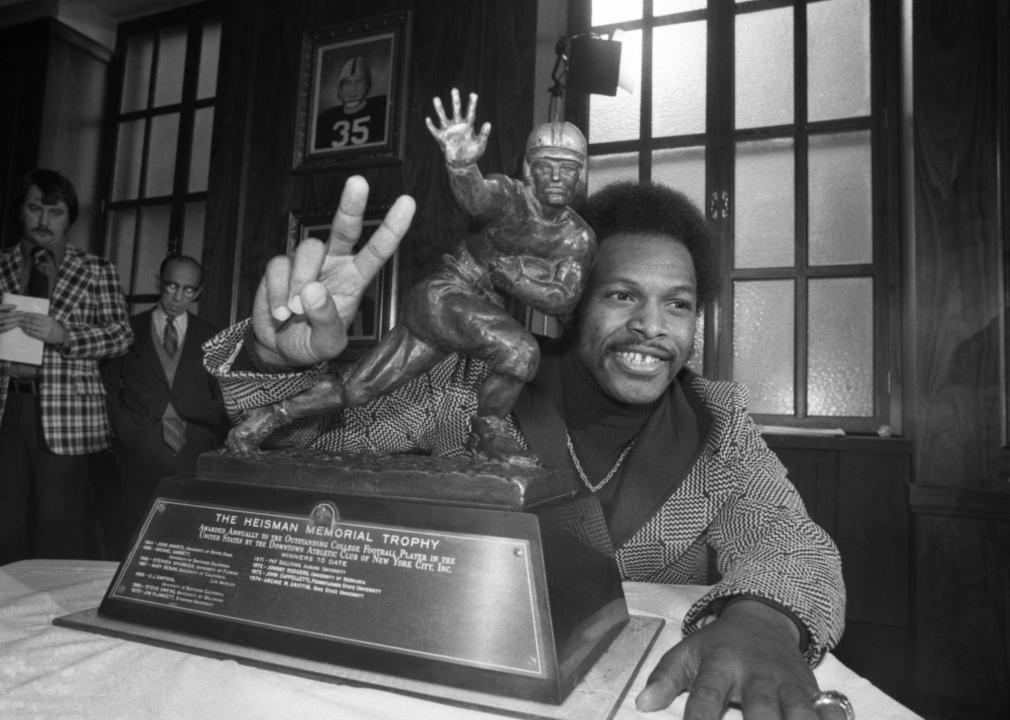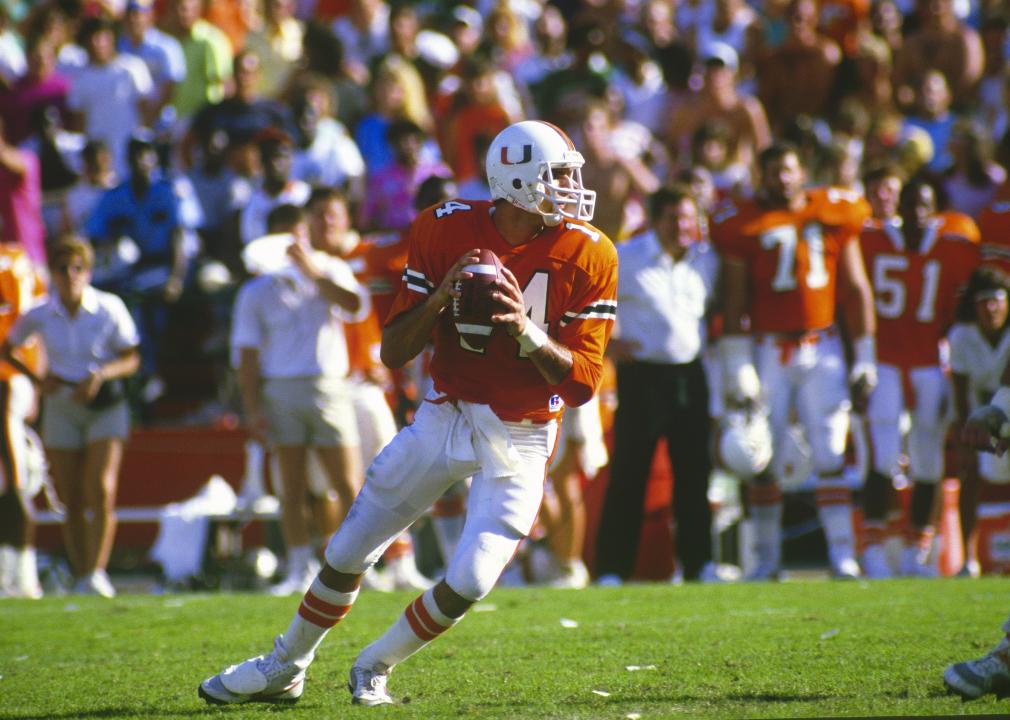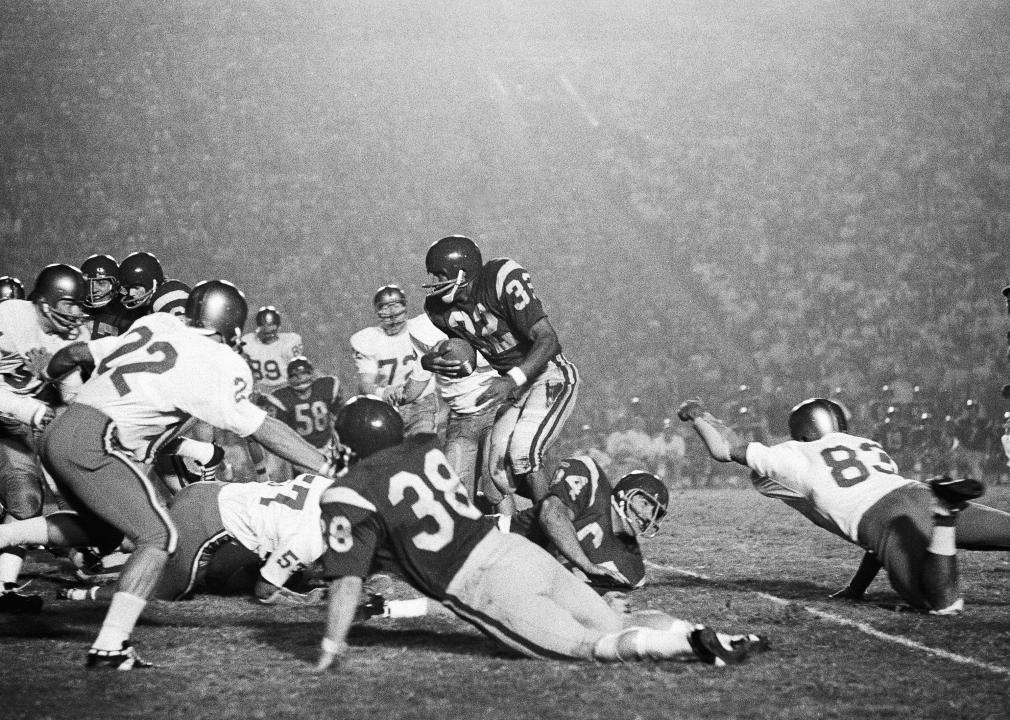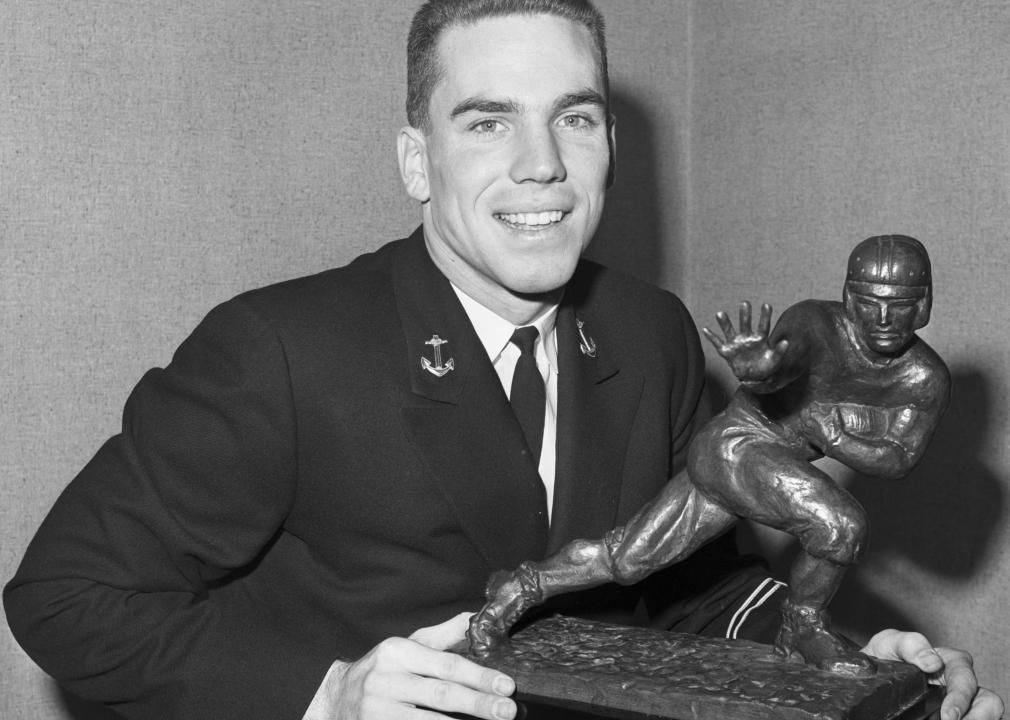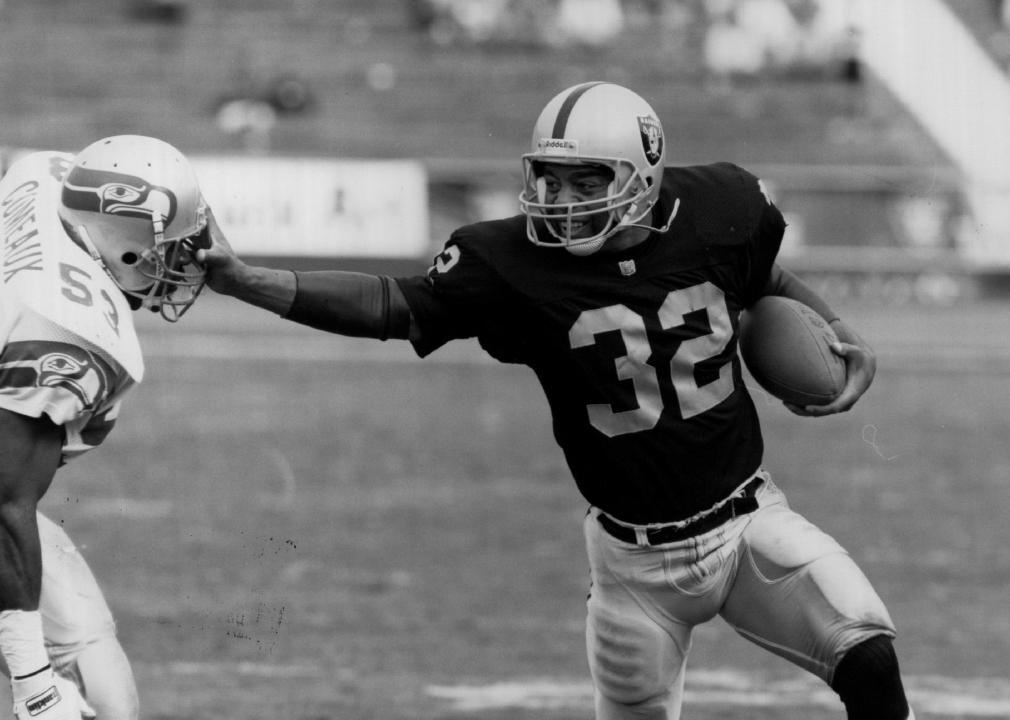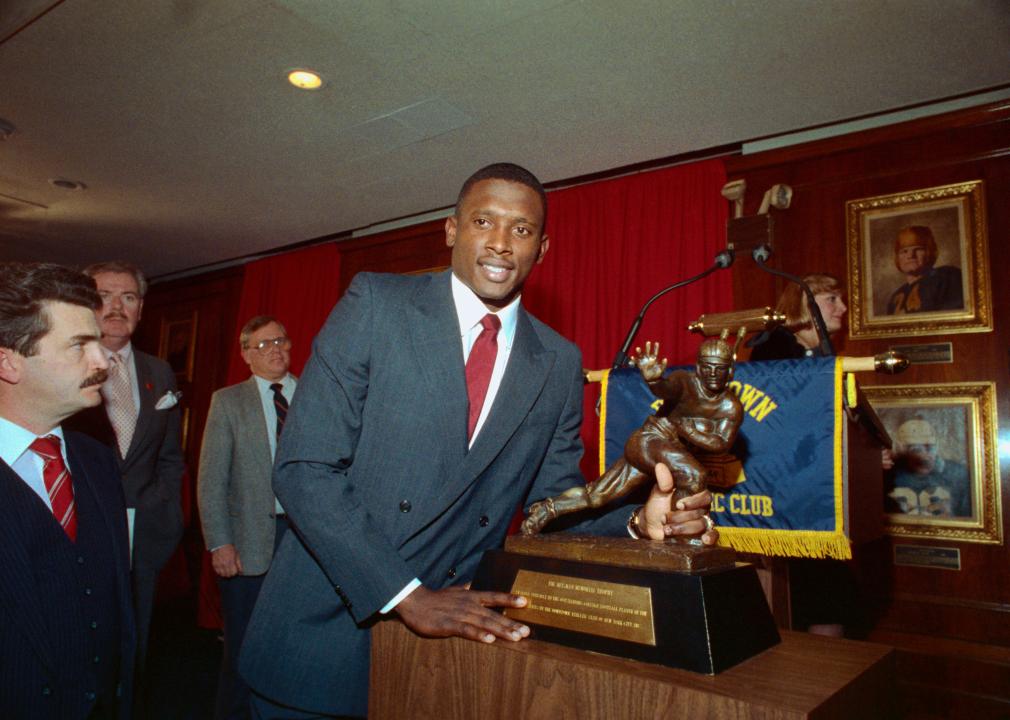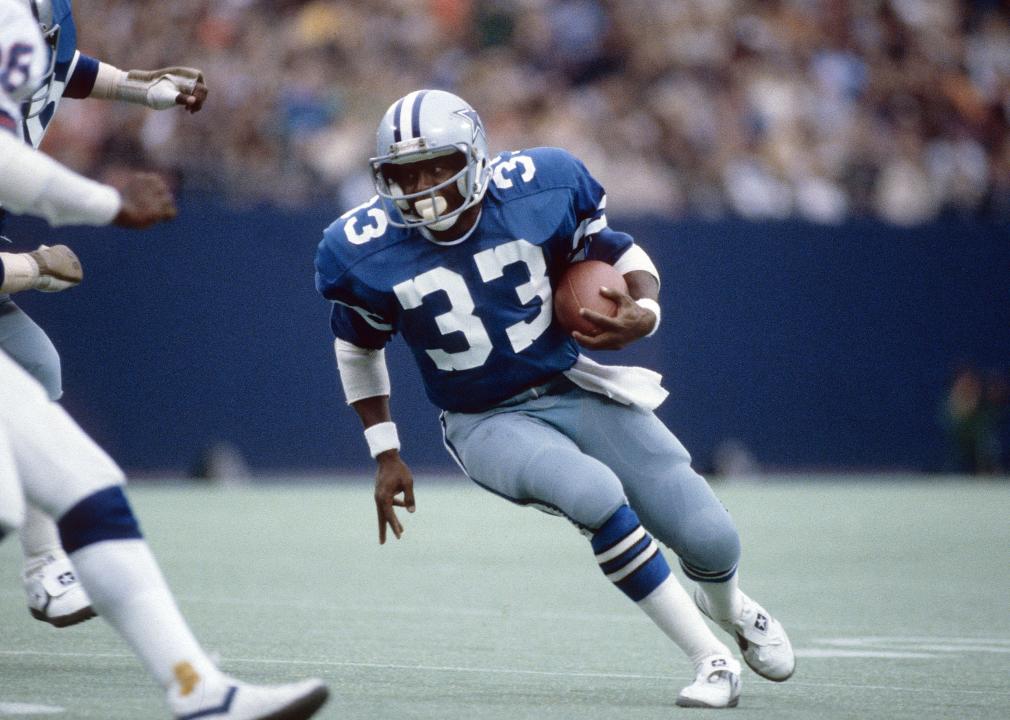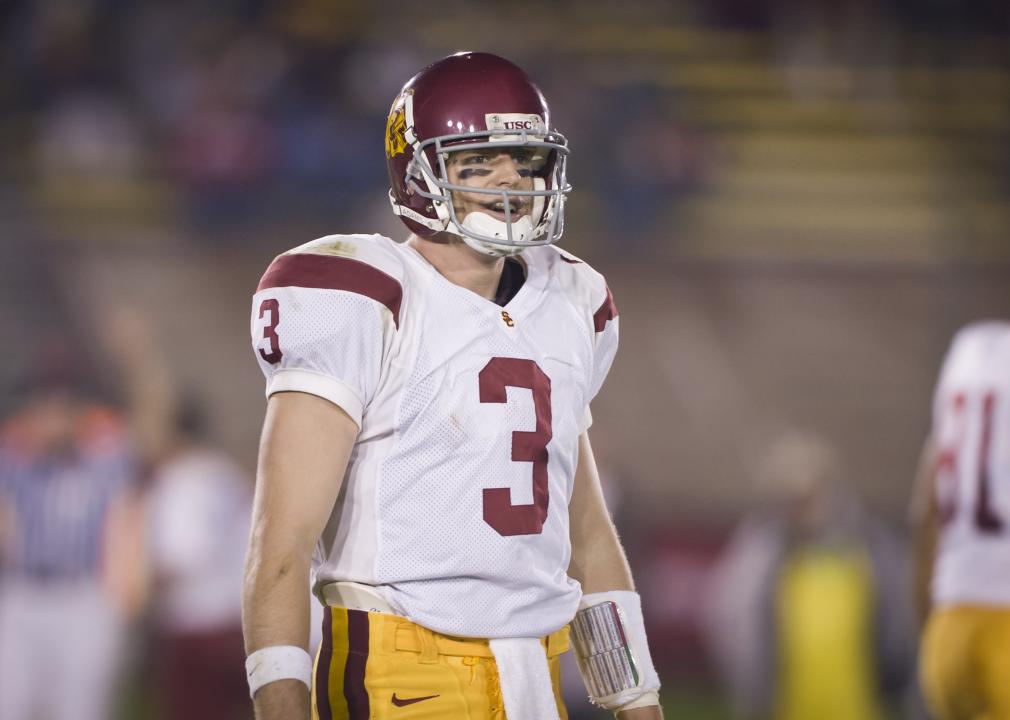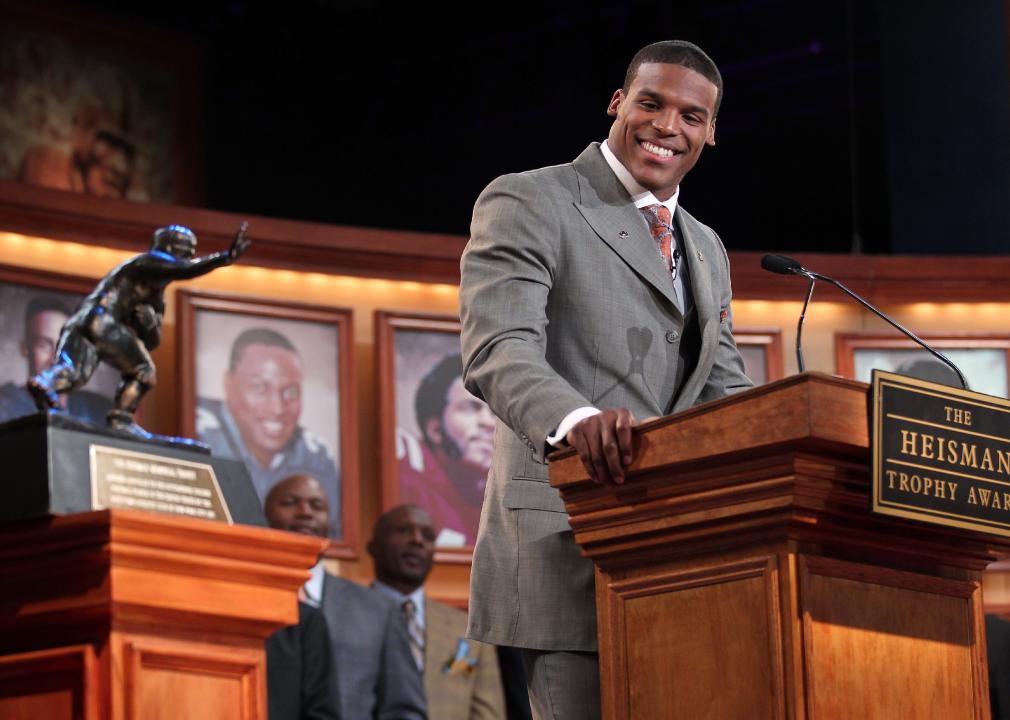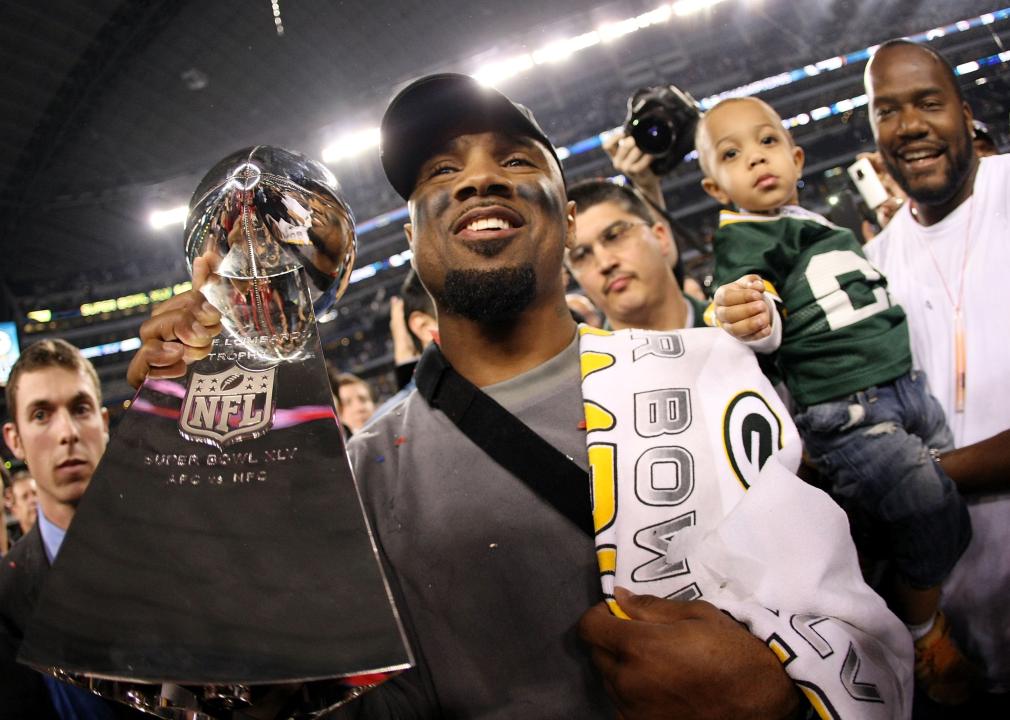Most successful Heisman Trophy winners
Bettmann Archive // Getty Images
Most successful Heisman Trophy winners
Archie Griffin of Ohio State holds up two fingers as he poses with the Heisman Trophy.
Every year, thousands of college football players begin a new season with hopes of having their name etched in history. Just one, though, can win the coveted Heisman Trophy—an annual award given to the most outstanding player in the game. The most prestigious award in college sports is earned through exceptional on-field play, and its winners have represented 40 programs.
The Heisman has also served as a springboard to NFL careers that will be remembered by generations of fans. Winners have experienced team success such as Super Bowl victories and added to personal accomplishments that were mythologized with the highest honor: gold jackets and busts for members of the Pro Football Hall of Fame.
Stacker compiled a ranking of the most successful Heisman Trophy winners in NFL history using Pro Football Reference’s weighted career approximate value, which quantifies a player’s overall impact by balancing peak production against raw totals. Heisman winners since 1960, which is as far back as the approximate value stat goes, were considered. Ties were broken by NFL games played.
![]()
Focus on Sport // Getty Images
#10. Vinny Testaverde
Vinny Testaverde #14 of the Miami Hurricanes drops back to pass.
– Position: Quarterback
– NFL games played: 233
– Weighted career approximate value: 97
The #1 pick in the 1987 draft had ample NFL success following a career at the University of Miami during which he threw for 6,058 yards and 48 touchdowns with 25 interceptions in four seasons. Testaverde’s NFL career spanned 21 seasons—tied for eighth on the all-time list. The New Yorker played for seven franchises and was selected for two Pro Bowls. He finished with 46,233 passing yards, 275 touchdowns against 267 interceptions, and a 56.5 completion percentage.
Bettmann // Getty Images
#9. O.J. Simpson
O.J. Simpson facing Miami in a game.
– Position: Running back
– NFL games played: 135
– Weighted career approximate value: 98
After Simpson reached the peak of football with the University of Southern California and in the NFL, he was found liable for the wrongful deaths of his ex-wife, Nicole Brown Simpson, and Ronald Goldman in a 1997 civil lawsuit. He was later convicted on unrelated charges of kidnapping and armed robbery in 2008.
He began his college career at the City College of San Francisco before spending two seasons at USC, where he rushed for 3,124 yards and 33 touchdowns. He matched his success in the NFL by being named an All-Pro five times and Most Valuable Player in 1973. Simpson, who played for the Buffalo Bills and San Francisco 49ers, rushed for 11,236 yards and 61 touchdowns in 11 seasons and became a Pro Football Hall of Famer in 1985.
Bettmann // Getty Images
#8. Roger Staubach
Roger Staubach poses with the Heisman Trophy.
– Position: Quarterback
– NFL games played: 131
– Weighted career approximate value: 104
Known as “Captain America,” Staubach found favor with fans early in his college football career as a leader for the United States Naval Academy. The Midshipman threw for 3,571 yards and 18 touchdowns with 19 interceptions and rushed for 17 scores in three seasons. He is the last player from a service academy to win the Heisman and served in the Vietnam War after graduation. Staubach entered the NFL as a 27-year-old in 1969 and spent his 11-season career with the Dallas Cowboys. He compiled 22,700 passing yards and 153 touchdowns with 109 interceptions, plus 2,264 rushing yards and 20 scores, and was part of the 1985 Pro Football Hall of Fame class.
Sporting News // Getty Images
#7. Marcus Allen
Marcus Allen of the Los Angeles Raiders runs with the ball circa 1980s.
– Position: Running back
– NFL games played: 222
– Weighted career approximate value: 104
Allen was one of the best running backs of all time. The 6-foot-2, 210-pounder from San Diego amassed 4,682 rushing yards and 45 touchdowns in four seasons at USC, including a senior Heisman campaign in which he rushed for 2,342 yards and 22 scores. The #10 pick in the 1982 draft won Super Bowl XVIII with the Los Angeles Raiders in 1984 and was named the game’s MVP. Two seasons later, Allen had the best year of his 16-year career, rushing for 1,759 yards—109.9 yards per game—and earning the Offensive Player of the Year and MVP awards. In 2003, Allen was inducted into the Pro Football Hall of Fame.
Bettmann // Getty Images
#6. Tim Brown
Tim Brown posing by his Heisman Trophy.
– Position: Wide receiver
– NFL games played: 255
– Weighted career approximate value: 105
The Notre Dame graduate thrived in South Bend, Indiana, stockpiling 2,493 receiving yards and 12 touchdowns, plus 442 rushing yards and four scores, in four seasons. Brown was just the second wide receiver to win the Heisman after Nebraska’s Johnny Rodgers in 1972.
He carried over that success to the NFL as a member of the Raiders and, for one year, the Tampa Bay Buccaneers. In 17 seasons, Brown recorded 14,934 receiving yards and 100 touchdowns on 1,094 receptions. The dynamic Dallasite also collected 3,320 career punt return yards with three scores and led the league in kickoff returns as a rookie. He was named to nine Pro Bowls and inducted into the Pro Football Hall of Fame in 2015.
Focus on Sport // Getty Images
#5. Tony Dorsett
Tony Dorsett of the Dallas Cowboys carries the ball during a circa 1980’s NFL game.
– Position: Running back
– NFL games played: 173
– Weighted career approximate value: 107
Dorsett became a household name in college by leading Pittsburgh to the national championship in 1976. That season, during his Heisman campaign, he ran for 1,948 yards and punched in 21 touchdowns, upping his career totals to 6,082 and 55, respectively.
He was the #2 pick in the 1977 draft by the Dallas Cowboys and was named the Offensive Rookie of the Year. Dorsett also became a Super Bowl champion that season. His NFL tenure spanned 12 years, including one with the Denver Broncos. The dual-threat—he had 398 receptions for 3,554 yards with 13 touchdowns—was selected to four Pro Bowls and was part of the 1994 Pro Football Hall of Fame class. He ended his career with 12,739 rushing yards and 77 scores.
David Madison // Getty Images
#4. Carson Palmer
Carson Palmer of the USC Trojans looks to the sidelines during an NCAA football game.
– Position: Quarterback
– NFL games played: 182
– Weighted career approximate value: 107
The third USC Trojan on this list, Palmer’s illustrious college career—11,388 passing yards with 71 touchdowns and 49 interceptions—featured a comeback from a collarbone injury. The 6-foot-5 Californian threw for 3,942 yards and 33 scores against 10 picks as a redshirt senior to propel himself to the Heisman.
His ability to orchestrate an offense made him the #1 pick in the 2003 draft by the Cincinnati Bengals, and he helped turn the franchise around with two playoff appearances in seven seasons. Palmer also spent time with the Oakland Raiders and Arizona Cardinals and was selected to three Pro Bowls. He overcame multiple serious injuries and threw for 46,247 yards and 294 touchdowns with 187 interceptions in 14 seasons. In 2019, Palmer was inducted into the Cardinals’ Ring of Honor.
Kelly Kline // Getty Images
#3. Cam Newton
Cam Newton of Auburn University speaks after being named the 76th Heisman winner.
– Position: Quarterback
– NFL games played: 148
– Weighted career approximate value: 115
Newton began his college career at the University of Florida before a stint at Blinn College in Texas, and then he earned a scholarship to Auburn University. During his junior year, he threw for 2,854 yards and 30 touchdowns with seven interceptions and led the offense with 1,473 rushing yards and 20 touchdowns—one of the best seasons of all time.
Newton, the #1 draft pick in 2011, led the Carolina Panthers to a Super Bowl 50 appearance with a 15-1 record, which included a 14-game winning streak to begin the 2015 season. Newton was named MVP as well as Offensive Player of the Year. He finished his 11-year career with 32,382 passing yards and 194 touchdowns to 123 interceptions. He also rushed for 5,628 yards and 75 touchdowns, figures that rank second and first all-time, respectively.
Doug Pensinger // Getty Images
#2. Charles Woodson
Charles Woodson celebrates with the Vince Lombardi Trophy after the Super Bowl XLV.
– Position: Defensive back
– NFL games played: 254
– Weighted career approximate value: 115
Woodson is the only cornerback on this list, as he is still the first and only defensive player to win the Heisman. The former Wolverine also helped Michigan on offense and special teams. Woodson collected 16 interceptions and scored five offensive touchdowns and one punt-return touchdown in three seasons.
He was the #4 pick in 1998 by the Raiders and sandwiched 11 seasons with the team around seven seasons with the Green Bay Packers. Woodson was named the Defensive Player of the Year in 2009 and two seasons later won Super Bowl XLV with the Packers. The nine-time Pro Bowler and two-time interceptions leader ended his career with 1,220 tackles, 33 forced fumbles, 65 interceptions, and 13 defensive touchdowns. Woodson was inducted into the Pro Football Hall of Fame in 2021.
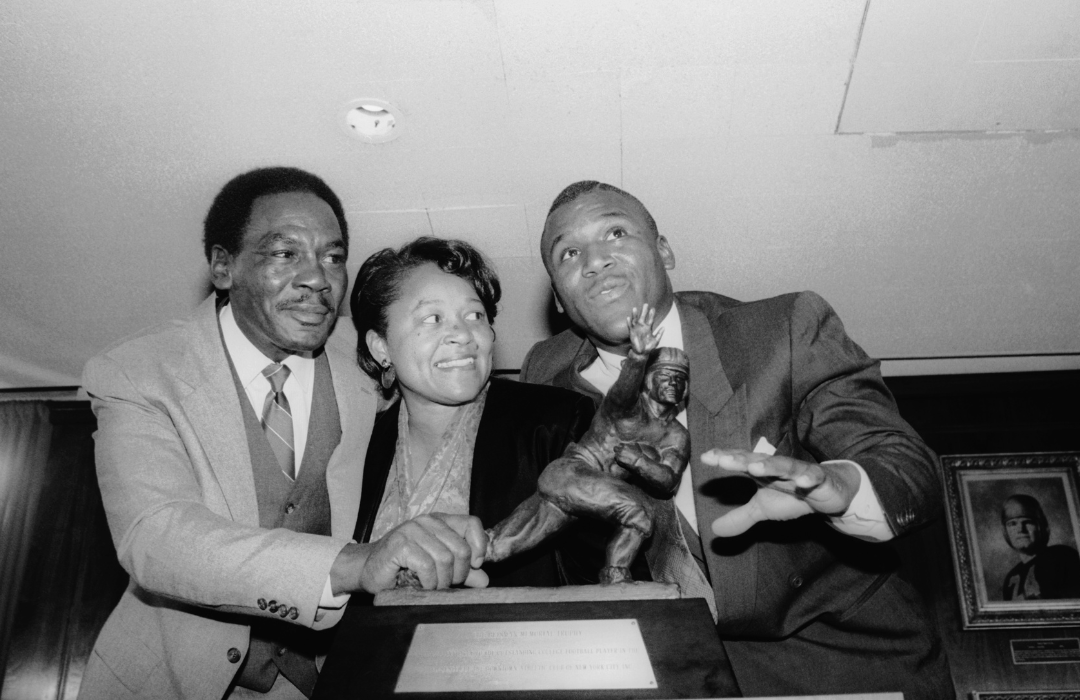
Bettmann // Getty Images
#1. Barry Sanders
Heisman Trophy winner Barry Sanders and his parents stand by the trophy.
– Position: Running back
– NFL games played: 153
– Weighted career approximate value: 120
The Oklahoma State product played his entire career with the Detroit Lions after three college seasons. At OSU, Sanders rushed for 2,628 yards and 37 touchdowns in just 11 games as a junior. His productivity made him the #3 pick in the 1989 draft—and he became the Offensive Rookie of the Year.
Sanders’ career reached new heights with 1,100 rushing yards and a Pro Bowl selection in each of his 10 years, and he captured the rushing title on four occasions. The 1997 MVP, two-time Offensive Player of the Year, and six-time All-Pro is considered one of the best to ever play the game. He ranks fourth all-time with 15,269 career rushing yards, and he was inducted into the Pro Football Hall of Fame in 2004.
Data reporting by Karim Noorani. Story editing by Mike Taylor. Copy editing by Robert Wickwire. Photo selection by Clarese Moller.
